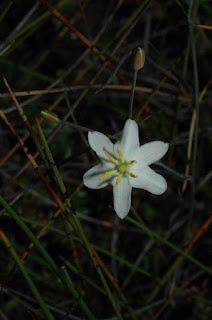I have previously posted about the female of this species - the Common Splendid Ghost Moth - Aenetus ligniveren.
She looked totally different from this fellow - so much so that when I found this one, I knew I ought to recognise it, but could not.
I had only ever seen pictures of the male, not the real thing. The female was brown with green patches on her wings.
This fellow was a lovely apple green with silver stripes across its wings, a silvery head, really large brown eyes. He was intent on hanging from stems of grasses and Lomandra leaves. The wings were held closed against the body, almost as a Fruit Bat does. A very strange wing position for a Moth.
Strangely, both encounters with this species were around the same time, and both involved Kirsten. The last one we a somewhat more personal encounter with Kirsten, as the female moth laid a clutch of eggs in Kirsten's hands, in the previous encounter.
This fellow was a lovely apple green with silver stripes across its wings, a silvery head, really large brown eyes. He was intent on hanging from stems of grasses and Lomandra leaves. The wings were held closed against the body, almost as a Fruit Bat does. A very strange wing position for a Moth.
Strangely, both encounters with this species were around the same time, and both involved Kirsten. The last one we a somewhat more personal encounter with Kirsten, as the female moth laid a clutch of eggs in Kirsten's hands, in the previous encounter.
On Sunday, we went down to Kirkland Road, looking for Orchids (of course). But as with all true Naturalists, anything and almost everything unusual is of interest to us both. Kirsten is more keen on insignificant herbs than I am, and especially grasses - but that is an on-going debate.
Anyway, I spotted this handsome Moth hanging from a stem of Lomandra, initially.
I suspect it was just warming itself up,
perhaps having only recently emerged from its pupa.
 |
| Aenetus ligniveren - Kirsten lining the moth up for a close-up. |
 |
| Common Splendid Ghost Moth - Aenetus ligniveren |
From above, you can see the silvery white head
the huge brown eyes.
The wings are wrapped around below the body.
with the leg in front of the eye, you can how hairy the legs are.
(Click to enlarge image).
 |
| Aenetus ligniveren - head on view of male |
. |
| Male Aenetus ligniveren hanging from grass stem by one leg. |
Note how the hairs on the body
have been brushed onto the eyes and face
of the Moth.
It has relatively small antennae, which actually surprises me.
But it matches this CSIRO specimen.
 |
| head view of male Aenetus ligniveren |


















































